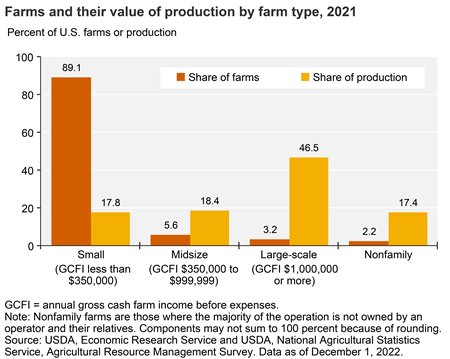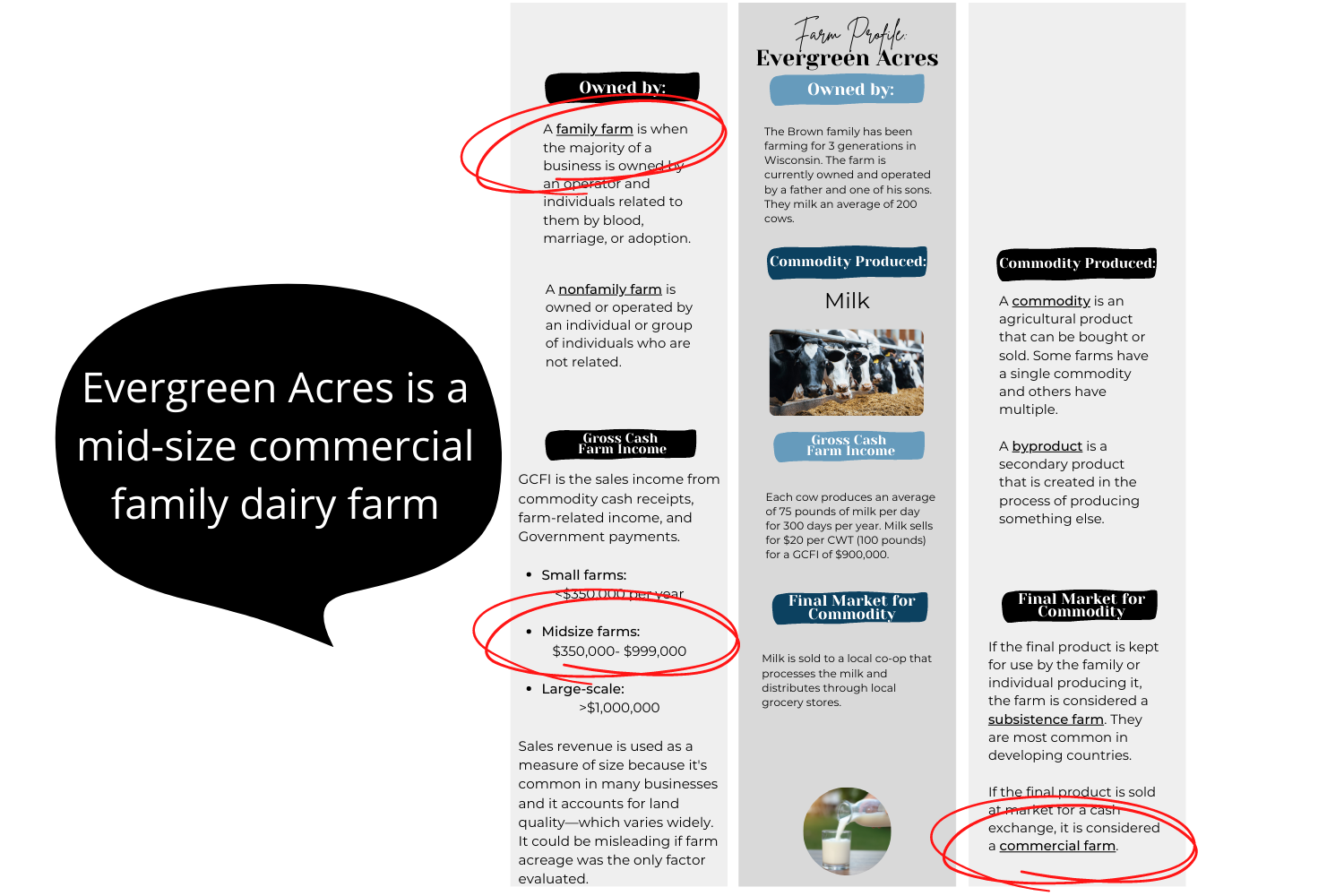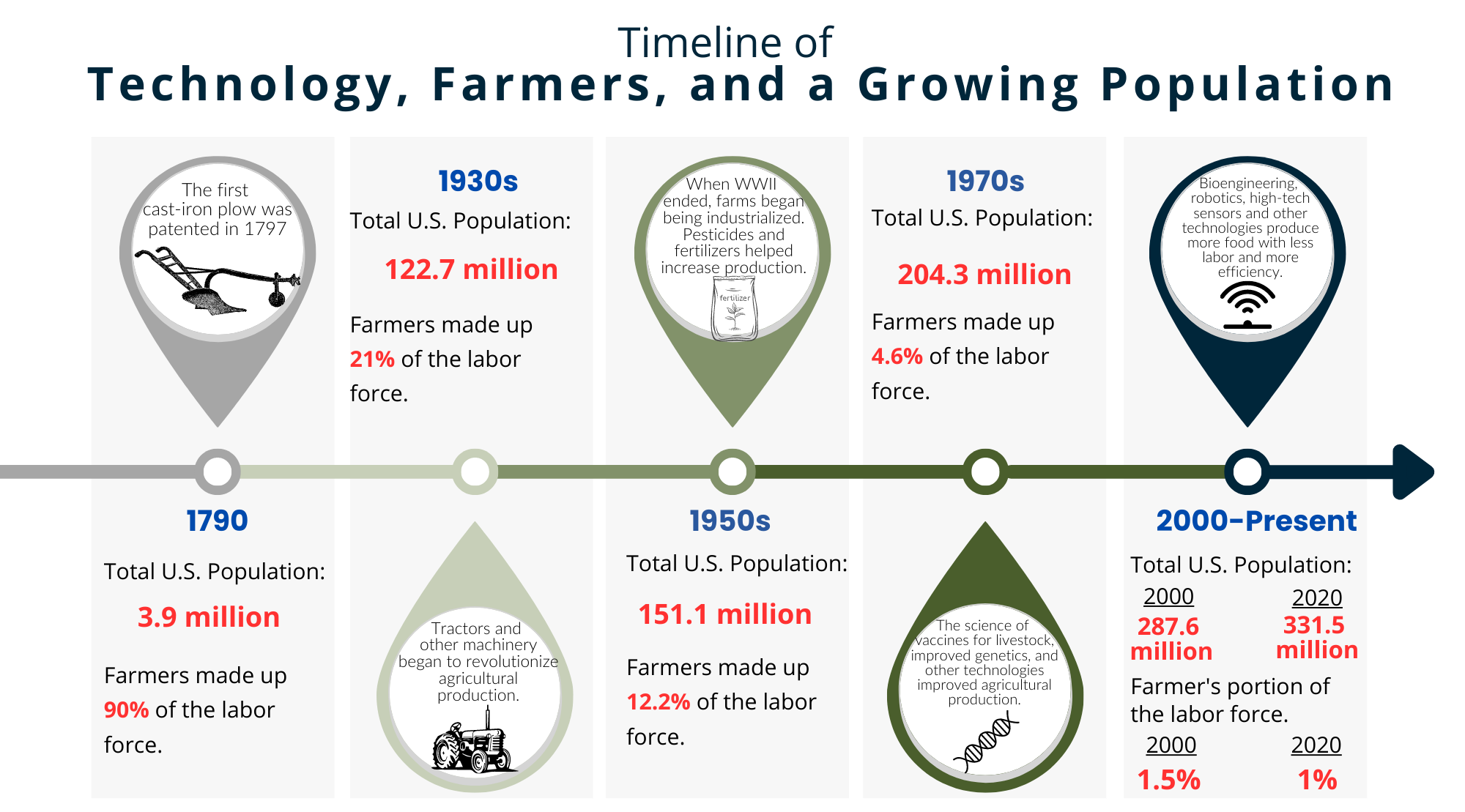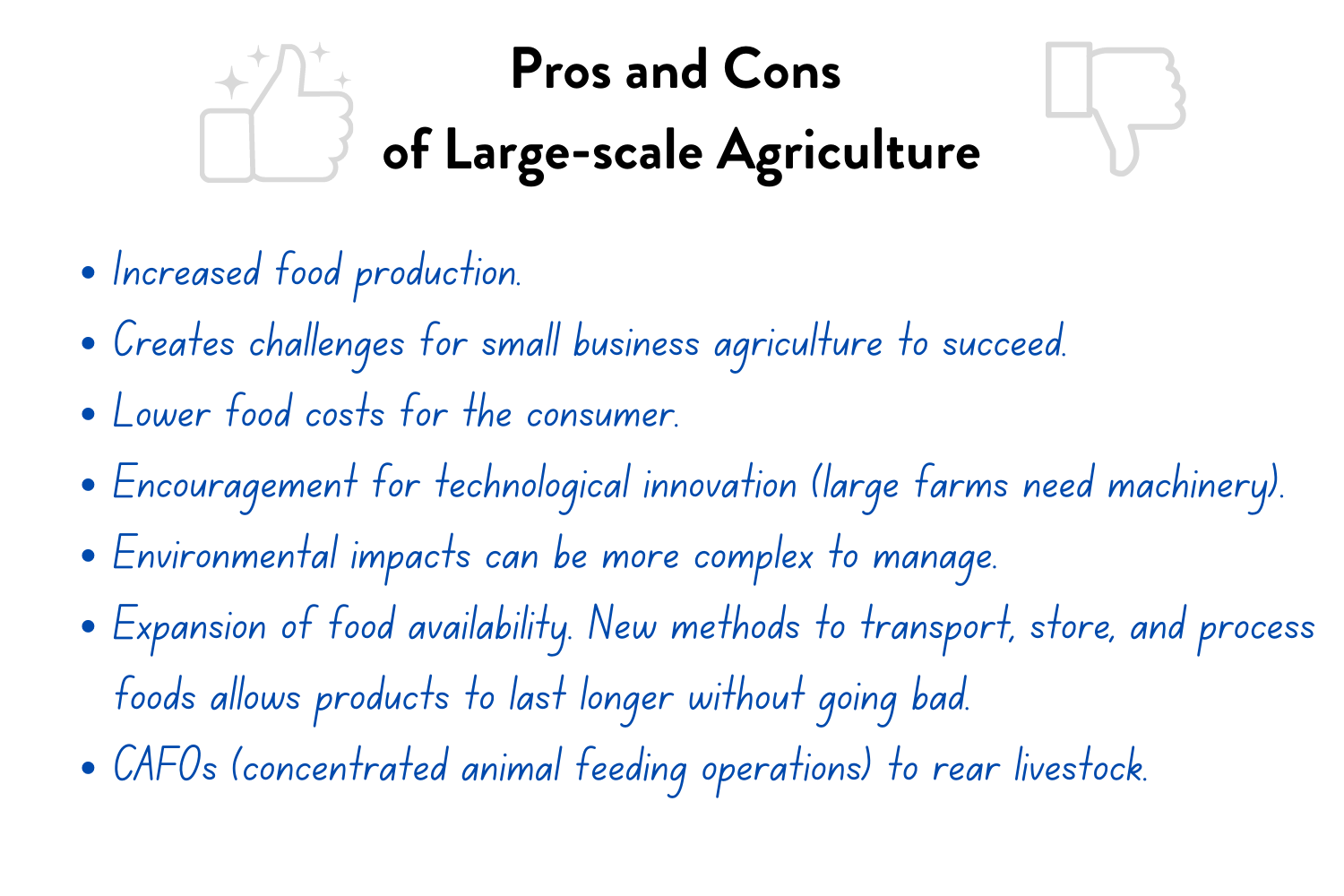Agricultural Literacy Curriculum Matrix
Lesson Plan
The Big Deal About Big Ag
Grade Level
Purpose
Discover how technological advances and economic forces influence the size of farms in the United States. Evaluate the pros and cons of large-scale agriculture for the production of our food, fuel and fiber and identify the similarities and differences in commercial vs subsistence farming.
Estimated Time
Materials Needed
Engage:
Activity 1: Exploring Farms
- Exploring Farms Notes, 1 copy per student
- Farm Profile Cards*, 1 copy per team of 2 students (cut farm profiles into individual cards or order from AgClassroom Store.)
*Farm Profile Cards can be ordered from agclassroomstore.com. They come in a classroom set that includes six color-coded sets of cards printed on durable cardstock.
Activity 2: What has made it possible for farms to get larger?
- Big Ag slide deck (continued)
- Technology, Farmers, and a Growing Population Timeline handout, digital version or hard-copy version
- The Future of Farming video
Activity 3: Economies of Scale
- Economies of Scale in One Minute
- Big Ag slide deck (continued)
Evaluation:
- The Pros and Cons of "Big Ag" handout, one copy per student
- Pros and Cons of Large-scale Agriculture image to project (optional)
Vocabulary
commodity: a primary agricultural product that can be bought and sold
comparative advantage: the ability of a business to make a specific product more efficiently than another company
competitive advantage: a condition or circumstance that puts a company in a favorable or superior business position
economies of scale: when the average costs per unit of output decrease with the increase in the scale or magnitude of the output
economies of size: a proportionate saving in costs gained by an increased level of production
fixed expense: business expenses that do not change each month
gross cash farm income (GCFI): the measure of a farm's revenue before deducting expenses
industrial agriculture: the primary system for food production in the United States; a type of farming which raises and cultivates large numbers of livestock and plants using modern technology
Did You Know?
- The average farm size tends to increase as a country becomes more developed and has a larger economy.1
- Smaller farms tend to achieve higher yields per hectare, but have much lower output per labor hour.1
- Small farms account for 32% of the world's food supply. Smaller farms tend to allocate a larger share of their crops towards food directly consumed by humans, rather than animal feed or biofuels.1
Background Agricultural Connections
Defining Farms by Size or Ownership
It is not uncommon for the terms "small farm" and "family farm" to be used interchangeably. However, this common practice creates a misconception that all family-owned farms are small or that large farms are not owned by families.
Family describes the ownership of the farm. A family farm is classified as one where the majority of the business is owned by an operater and individuals related to the operator.5 The relatives may or may not live in the operator's household. Family farms can be any size. They range from small to very large. In fact, 98% of farms in the United States are owned by families.4 Nonfamily farms are classified as those where an operator and persons related to the operator do not own a majority of the business.5
Farm size is classified according to the farm's gross cash farm income (GCFI) rather than the physical size of the farm.6 GCFI is a measure of the farm's revenue before deducting expenses. It includes sales of crops and livestock, payments made under agricultural federal programs, and other farm-related cash income.5 Farm size is not measured in acreage because the agricultural potential of one acre varies depending on the climate where it is located. For example, a non-irrigated acre in a desert climate cannot be compared to a fertile acre with high rainfall in a temperate or subtropical climate.
In the United States, farm sizes are classified as follows5:
- Small farm: GCFI less than $350,000
- Midsize farm: GCFI between $350,000 and $999,999
- Large farm: GCFI above $1,000,000
The terms conventional agriculture, contemporary agriculture, intensive farming, industrial agriculture, factory farming, and to some extent modern agriculture, are synonymous terms. Modern agriculture and smart farming are newer terms used to define production systems on the cutting edge of farming technology (digital and mechanical) designed to reduce inputs (labor, fertilizer, pesticides and water) and decrease environmental impacts, at scale.
An important question is, "Are large-scale farms replacing small farms in the United States?" In 2020, 89% of all farms in the United States were small farms. While small farms are an overwhelming majority of farms, they only contribute 20% of the total farm production. Large-scale farms account for 2.9% of farms, but provide 46% of total farm production.8 In summary, we have more small-scale farms than large-scale farms in the United States, but large-scale farms contribute the largest percentage of agricultural products to our society. 
Economics and Farm Size
Economies of size is a term used in economics to explain that the average cost per unit of production decreases as the size of a business or operation increases. For example a small dairy farm with 300 head of milk cows will have higher production costs (per gallon of milk produced) than a large-scale dairy with 3,000 head of milk cows. Here are some factors that contribute to the varying production costs9:
- Both small and large farms have fixed expenses to purchase the equipment that they need to operate. A large farm can spread more production over the same level of fixed expenses.
- Sometimes volume discounts can be obtained for inputs such as seed, fertilizer, or other expenses.
- Costs can be reduced by spreading the resources over more than one enterprise.
- Large-scale farms are more likely to be capable of investing in labor-reducing technologies.
Economies of scale describes how much production increases as the farm (or business) increases its scale of production.
Another factor that influences farm size is processing. Farmers produce raw commodities such as milk, beef cattle, hogs, corn, and soybeans. However, those raw products need to be processed. Beef cattle need to be harvested and the meat needs to be cut into retail packages. Milk is pasteurized, homogenized, bottled, and/or used to make cheese, yogurt, butter, and other dairy products. Grains like wheat, oats, and corn are milled into flour or processed into a variety of food or feed products. Processing plants are also subject to economies of size and scale. Over the years, processing plants have grown larger in size and capacity, but smaller in numbers. To be profitable, a large processing plant will favor large producers because they can be more efficient and cost effective.9
Technology on the Farm and in Processing
Technology is another contributing factor to farm size. Farm size is limited to the amount of work that can be completed from start-to-finish in producing a commodity. Technology has increased the capacity of farmers to perform work through the decades. The production of grain crops like corn, wheat, or soybeans is highly mechanized. With the aid of modern tractors and combines, massive amounts of these commodities can be produced. However, some crops like fruits and vegetables still require a significant amount of manual labor to plant and harvest. Whether necessary farm tasks (such as planting, irrigation, or harvesting) are completed manually or by machine will influence the overall size of the farm.
Unlike competititve advantage where one business is able to differentiate itself over its competitors, comparative advantage is another consideration that is evaluated in business and economics. Farms are businesses. Comparative advantage is when a business has an advantage compared to other similar businesses. In agriculture a comparative advantage could come from the climate or location of the farm. A dairy farm in a temperate climate will need fewer buildings and facilities than a dairy farm in a very cold climate. Other examples of comparative advantages include availability for labor, location (distance from markets), or skills and experience of farm managers or workers.
Economics and technology are the two elements that have made large-scale farming both possible and economically viable.
Is industrial agriculture positive or negative? The pros of industrial agriculture include increased food production for a growing population, lower consumer costs, the encouragement of technical innovation, the creation of employment opportunities, and the expansion of food availability. Cons of industrial agriculture include negative impacts on small business agriculture and environmental concerns and impacts that can become problematic when raising livestock or produce crops on a large scale. Another factor to consider is the use of CAFOs, or concentrated animal feeding operations for the rearing of livestock. Determining if livestock housing systems are a pro, con, or neutral issue varies by individual perspectives. When we industrialize, we use the "factory model" for efficiency. Consumers do not have a problem with this process when we are making/manufacturing cell phones or a product that is non-sentient (devoid of feeling or sensation). However, animals are sentient and the factory approach can seem (to some) insensitive to animal needs. A closer look at modern, large-scale animal farms can help consumers evaluate if and how the needs of animals can be met in an agricultural setting. Use the lesson Hen House Engineering to explore the housing of laying hens.
Engage
- Using your white board or a projection system, display the true/false statements found on slide 2 of the Big Ag slide deck.
- Large-scale farms are replacing small farms in the United States.
- Large-scale commercial farms are replacing small family farms in the United States.
- Family farms are dwindling in the United States.
- Factory farms are replacing family farms in the United States.
- Industrialization is the process of transforming the economy of a nation or region from a focus on agriculture to a reliance on manufacturing.
- Ask students to study the statements and the terminology used in each statement and determine their best guess for if the statement is true or false.
- Once students have had a chance to make guesses and conclusions using their prior knowledge, progress to slide 3 where the following words are highlighted: large, small, commercial, family, and factory.
- Ask students to share their perspectives on what these adjectives mean. For example, what is a small vs a large farm? What is a commercial farm? What isn't a commercial farm? What size is a family farm? How are all these farms different and the same?
- Use slides 4-7 to define vocabulary terms used to describe farms by ownership and size.
- Propose the following questions for investigation, "What has made it possible for farms to get larger?" and " Why do we see larger farms in the United States and in other countries with large, market-driving economies?" (slide 8)
Teach with ClarityA term you or your students may have heard is "factory" farming. It is sometimes used to describe large-scale livestock farms that are called CAFOs, or concentrated animal feeding operations. These livestock farms use sophisticated technology for feeding, manure management, and air quality that looks much different than the traditional vision some consumers have of farm animals that are housed in red barns with lots of straw. Use proper terminology in the lesson, but be aware of consumer terms that may be part of your students' prior knowledge or media experience. |
Explore and Explain
Activity 1: Exploring Farms
- Give each student one copy of the Exploring Farms Notes.
- Divide students into teams of two. Give each team of students one set of the Farm Profile Cards.
- Instruct students to explore the farm profiles by placing each card on the explanation sheet found on page four of their Exploring Farms Notes. The explanation sheet will help students identify the size, ownership, and type of each farm. It will help them sort the profiles as directed in steps one, two, and three. Inform students that the activity is intended to help them visualize farms of different sizes, ownerships, types and locations. Slide 10 of the lesson slide deck has an image to use as an example.
- Write the following phrases on the board for each student group to complete after they finish reviewing the profile cards: "I'm surprised by..." and "I wonder..."
- Use these phrases and student responses to guide a class discussion. If students need prompts, use the following questions:
- Were you surprised by the size of a small-scale farm? Was it bigger or smaller than they would have guessed?
- Did you notice a correlation in size classification from species to species in livestock? Does a small broiler chicken farm have the same number of animals as a small cattle ranch?

Activity 2: What has made it possible for farms to get larger?
- Select a couple of farm profile cards from the deck. List a few quick statistics about the farm and then ask, "Could this farm have existed in the 1800s? How about 1910 or 1950?" (likely no) Repeat these questions for one or two additional farms. (slide 12)
- Brainstorm factors that limited the size of farms in history.
- Explore the Technology, Farmers, and a Growing Population Timeline using one of the following options:
- In-class: Project the image from the Big Ag slide deck on the board (slide 13) first showing the dates, population, and percentage of the labor force that were farmers. Next, add the technology examples (slide 14). Ask, "What has made it possible for farms to get larger?
- Homework or student-directed: Give each student one copy of the Technology, Farmers, and a Growing Population Timeline handout. You can share the digital version with live links or the hard-copy version with QR codes. Instruct students to visit the specific links to the Growing a Nation Interactive Timeline to fill in the blanks found in the timeline and then to answer the questions.

- Watch, The Future of Farming.
- Summarize the question, "What has made it possible for farms to get larger?" (Technology)
Activity 3: Economies of Scale
- Have students think back to Activity 1 when they classified the size of farms based on the GCFI. Point out to students that farms are businesses and that they need to earn a profit to continue to operate. Ask, "What business or financial element have we NOT yet considered?" (Operating costs and profit. GCFI only considers the money that is brought into a farm business when a commodity is sold. It does not consider operating costs and net income.)
- Watch Economies of Scale in One Minute to introduce the concept of economies of scale.
- Ask students if economies of scale applies to farming businesses. (yes)
- Beginning on slide 18 of the Big Ag slide deck, describe examples of how large scale farming can be more economically sustainable.
- Using slide 21, ask students if farms can simply get bigger to be more economically sustainable and efficient (no). Discuss limitations. (Money. Technology is expensive. Land may be limited in their area. Regulations and permits may limit growth to a specific level. Climate and weather may limit growing seasons. Etc.)
Elaborate
-
Have students read Small Farms, Big Differences.
-
Project the USDA table, Most farms are small, but the majority of production is on larger farms. Provide assistance as needed to interpret the graph. Ask students to consider the hypothetical circumstance that we no longer had large-scale farms—only small and midsize farms. Provide the following questions as prompts and assign students to write a short descriptive essay about what our world and food system would look like.
-
How would the cost of food be impacted?
-
How many small and medium size farms would be necessary to make up for the 46.5% of agricultural production that would be (hypothetically) lost from the large-scale farms.
-
Would environmental impact and natural resource use be the same, more, or less?
-
How would employment and the job market be impacted? Would there be more jobs or less?
-
-
Compare and contrast subsistence agriculture in less developed countries with homesteading in the United States. What are the similarities and differences in these farming practices and lifestyles? (Both involve agricultural practices with the intention of supporting a household with food and other necessities. However, subsistence farming in a less developed country would be practiced based on a necessity to live. Homesteading in the United States is more likely a chosen lifestyle driven by the desire to produce their own food.)
Evaluate
- Give each student one copy of, The Pros and Cons of "Big Ag" handout.
- Instruct students to summarize what they view as the pros and cons of large-scale agriculture.
- Optional Variation: Divide your class into two groups. Instruct half of the students to list the pros and cons of large-scale agriculture while the other group lists the pros and cons of small-scale agriculture.
- Continue the discussion as a class and fill in holes. Project the Pros and Cons of Large-scale Agriculture image to provide prompts to students if needed. (Image can also be found at the end of the Big Ag slide deck.) They should decide if they consider each of the bullet points a pro or a con.

- Once students have considered the pros and cons, have them answer the following question on the back of their worksheet or in a class discussion, "If we no longer had large-scale farms, what would be different?"
- Review the following key concepts:
- Family farms are owned and operated by members of the same family. Family-owned farms make up the vast majority of farms in the United States and can be any size.
- Technology makes large-scale farming possible. Without it, farms size would be limited to the amount of work that can reasonably be completed manually.
- The average cost of production for any agricultural product decreases as the size of a business increases. This economic principle gives one explanation for why large-scale farms have more economic resiliance and sustainability than small-scale farms.
- A commercial farm produces an agricultural product with the intent to sell it. The opposite of commercial farming is subsistence farming. Subsistence farms are primarily found outside of the United States in developing countries.
Sources
- Farm Size and Productivity | Our World in Data
- Small family farmers produce a third of the world’s food | FAO
- Smallholder farming is a proven path out of poverty, but climate change is changing the rules | Gates Foundation
- A Look at America's Family Farms | USDA
- Farm Structure and Contracting | USDA ERS
- Family Farms | USDA NIFA
- Farming and Farm Income | USDA ERS
- Most farms are small, but large farms account for the largest share of production value | USDA ERS
- Economies of Size in Production Agriculture | NIH
Recommended Companion Resources
Author
Organization
| We welcome your feedback! If you have a question about this lesson or would like to report a broken link, please send us an email at matrixelearning@gmail.com. If you have used this lesson and are willing to share your experience, we will provide you with a coupon code for 10% off your next purchase at AgClassroomStore. |
